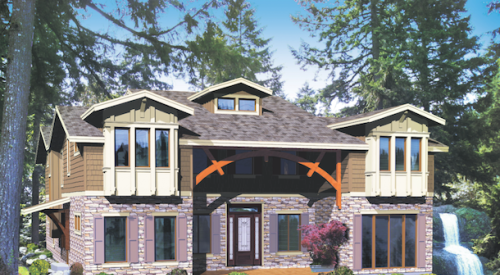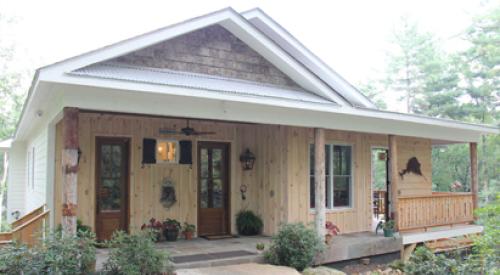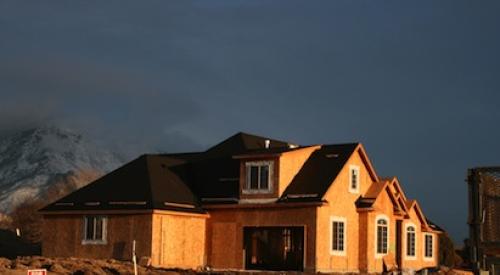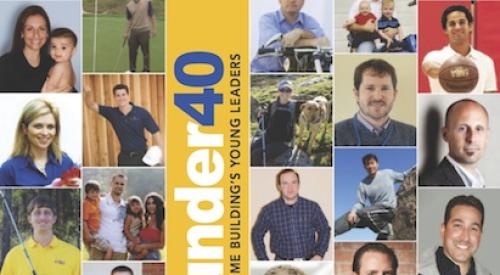Green in the Emerald City
Nicknamed the Emerald City because of its lush green climate, it's not surprising Seattle has a long association with sustainability and conservation.
A notable 28 percent of homes built in the greater Seattle area in 2008 were certified Built Green, a certification program developed by the Master Builders Association of King and Snohomish Counties, in partnership with the two individual county governments and other agencies in Washington State. At its height in 2006, 3,107 homes were certified Built Green; the actual number of homes certified in 2008 represents less than half of that, but the 2006 figure represented only 24 percent of the market back then.
The 2009 Built Green program has an application process to access funds to build green. "Our program worked with King County and Seattle Public Utilities to put together a pool of money to get builders to move up from a 3-Star to a 4- or 5-Star level [of certification]," says Aaron Adelstein, executive director of Built Green. Builders can apply for a cash award of between $2,500 and $20,000 per project to step up to those higher levels.
Though Seattle has a reputation for being environmentally progressive, production builder Matt Howland, who's built hundreds of Built Green certified homes in the past seven years, says he succeeded initially by selling buyers on the value of good indoor air quality and lower utility bills. But brand recognition and acceptance is building.
"Now we're starting to get some traction," Howland says. "In the last few years, people have started to look for and limit their search to homes that are Built Green."
GREEN STATS
Market: Seattle
Local green building program: Built Green, administered by Master Builders Association of King and Snohomish Counties
Year created: 2000
Homes built in market that follow the program in 2008: 1,393 homes.
Homes built overall under the program: More than 14,000 projects since the program began
Market penetration (percentage of all homes built in the market) in 2008: 28 percent in King County (Seattle is its county seat)
Source: Built Green, Master Builders Association of King and Snohomish Counties
 |
Green and Weird
The state capitol of Texas prides itself on being off-beat. Its small-business community embraces the slogan "Keep Austin Weird" because it wants to embrace the city's reputation for creativity, entrepreneurship and progressive thinking.
No wonder Austin was the first municipality in the country to establish a local green building program 18 years ago.
"We don't do LEED [for Homes] in this market," says Mary McLeod, residential program coordinator for the Austin Energy Green Building Program, "because we have our own program precisely designed for us. We preceded LEED. We helped set up the [U.S. Green Building Council] program and helped develop the LEED rating."
Austin Energy, which administers the green building program, offers direct rebates to solar contractors for installing photovoltaics for solar energy and water heating. The rebate is $3.75 per watt, which pays between 40 percent and 60 percent of the cost of installing a system. According to the Austin Energy Web site, the typical cost of installing a one kilowatt solar photovoltaic system — the smallest considered practical — is between $6,250 and $9,375. Austin Energy will rebate $3,750 ($3.75 × 1,000 watts) of that.
Jim Rush, principal of Jim Rush Green Builder, only certifies with the Austin Energy program. He likes that the program is specific to the Austin climate.
"Green is how houses should be built," Rush says. "It's not anything over and above or anything extraordinary. It's good building practices at their most fundamental."
GREEN STATS
Market: Austin, Texas
Local green building program: Austin Energy Green Building
Year created: 1991
Homes built in the market that follow the program in 2008: 1,022 homes for fiscal year 2008, which ended October 2008
Homes built overall under the program: 8,561
Market penetration in 2008: 25 percent
Source: Austin Energy Green Building Program
 |
Green is Just Peachy
Atlanta's EarthCraft House program has been so successful, it's spread beyond Atlanta to other areas of Georgia and cities in South Carolina, Alabama, Tennessee and Virginia The once local-only program was created by the Greater Atlanta Home Builders Association in partnership with Southface in 1999.
But as great as the EarthCraft program is doing, it has been deeply affected by fewer homes' being built.
"We used to be able offer incentives such as putting you at the front of the line for your permit," says David Ellis, executive vice president of the Greater Atlanta Home Builders Association. "Now there's no line. The economy's slow. But we've been looking at how we can green our building codes."
"There were a lot of mostly smaller local production builders that helped put the program together," says Carl Seville, a green building consultant and former builder involved in the creation of EarthCraft. "Most of them are basically out of business."
Atlanta, unlike Portland or Boulder (neither of which are examined in this article because building activity there is particularly slow right now), didn't have a history of embracing green back in 1999 when EarthCraft started. "It was a coming together of things," says Ellis. "There were some builders in our market who were trying to push the envelope and saw the future. At the same time, there was also Southface Energy Institute. It was here and was a very natural partner."
GREEN STATS
Market: Atlanta
Local green building program: EarthCraft House
Year created: 1999
Homes built in market that follow the program in 2008: 1,700
Built overall under the program: More than 4,500 EarthCraft homes in the Atlanta area; 7,769 in total throughout the Southeast since the program began
Market penetration in 2008: 8 percent
Source: Southface and Greater Atlanta Home Builders Association
 |
Everything Green is New Again
The Albuquerque market has three green home building certification programs that are actively used, though all are relatively new compared to green programs in other markets. But the city's history with energy-efficient, sustainable building runs deep.
"In the 1970s, New Mexico was truly the leader in passive solar, sustainable architecture and solar adobe," says John Bucholz, green building program manager for the city of Albuquerque. It's also around this time that architect Ed Mazria moved to New Mexico to start his practice and published "The Passive Solar Energy Book." Mazria is also the creator of the 2030 Challenge, which pushes for all buildings in the United States to be carbon neutral by 2030.
The HBA of Central New Mexico has been an active proponent of green building since 1997 and has tried a few programs before settling on Build Green, launched in 2006. There have been 145 Build Green New Mexico certifications statewide since January 2008.
The city of Albuquerque administers the Green Path voluntary certification program. All residential Green Path projects must be LEED for Homes or Build Green New Mexico Silver-certified with a HERS rating of 60 or better. Green Path metrics are a subset of the LEED-H and BGNM certified homes, so at 15 percent penetration for Green Path alone (which can only certify within Albuquerque's city limits), there's quite a bit of green building going on in the city and surrounding area.
Tom Wade, president of Artistic Homes, appreciates the incentive of fast-track permitting that's offered for green projects because all his homes are LEED-H certified. He builds entry-level and move-up homes, proving that building green — even LEED-H green — doesn't have to be expensive.
"Our [baseline] LEED homes here in Albuquerque are about $159,000," says Wade. "You can get a LEED-H Platinum home in a certain community for about $215,000 for about 1,300 square feet."
GREEN STATS
Market: Albuquerque
Housing Permits issued in 2008: 2,555
Local green building program: Green Path
Year created: 2007
Homes built in the market following the program in fiscal year 2009 (ending June 30, 2009): 52 Green Path residences
Homes built overall under the program: 65
Market penetration in 2008: 15 percent
 |
California's Code Green
California may be the only state where green building has been largely codified. Administered by Build It Green, the GreenPoint Rated program is based on California's Energy Efficiency Standards for Residential and Nonresidential Buildings, known as Title 24.
"Title 24 is mandatory," says Elise Hunter, government relations project manager for Build It Green. "One of the basic prerequisites for GreenPoint Rated is you have to build a new home at least 15 percent more energy efficient than Title 24 requires."
Alameda County Waste Management Authority has had a great influence on the receptivity to green practices here. The organization, founded in 1976, has a single-minded focus on waste reduction and rewards businesses and institutions that develop innovative projects. Not surprisingly, the GreenPoint Rated program got started in Alameda County and has since spread throughout the Bay Area and statewide.
Though 6 percent penetration in the Alameda County market is modest, many builders here are also certifying LEED-H and with the California Green Builder state certification program. Incentives to build green exist, but a number of local jurisdictions — including Alameda County — have adopted code requirements based on GreenPoint Rated.
"We adopted mandatory green building standards," says Cheryl O'Conner, acting executive director for the HBA of Northern California. "We were the first HBA in the country to do that. These mandatory building standards were with Build It Green. We were proactive in designing the program. Because we brought in all the stakeholders, we knew it would work for builders."
GREEN STATS
Market: Alameda County, Calif.
Local green building program: GreenPoint Rated, administered by Build It Green California
Year created: 2006
Homes built in market that follow the program in 2008: 777 in the entire Bay Area (of which Alameda County is a part)
Homes built overall under the program: 1,153 in the Bay Area, 2,106 total
Market penetration in 2008: 6 percent
RELATED ARTICLES
5 Markets to Watch
Green Building Survey Result
Sustainable Landscaping: The Next Step in Green Building
Austin's New Urban Village












